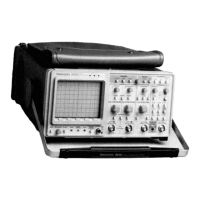3-59
The output from U770A is applied directly to sampling
switch U560A, an enhancement-mode MOS-FET device.
The switch gate is controlled via 0660 by the OSAM1
(Output Sample from Channel 1) logic signal, and is closed
when the data being Shifted out of the CCD is stable.
When OSAM1 is LO, the switch is on, and hold capacitor
C561 charges to the signal level of U770A. When OSAM1
is HI, the switch is off, and C561 holds its voltage level.
Figure 3-3 (shown previously in the "System Clocks"
description) shows the timing of OSAM1 and OSAM2 dur-
ing the Slow-Out and Short-Pipe modes of CCD operation.
During Fast-In mode, OSAM1 and OSAM2 are both
held LO.
Track-and-Hold Amplifiers and Multiplexers
The Track-and-Hold Amplifiers and Multiplexers allow a
single A/D Converter to digitize all the analog samples
from both CCD arrays by time-multiplexing the output
samples to the single converter. The four Track-and-Hold
circuits are identical; and, for brevity, only the CH 1-Side
1 circuitry will be described.
Side 1 signal outputs from U450 are applied through
R876A and R876B to the bases of U775A and U775B.
Transistors U775A and U775B form a differential trans-
conductance amplifier that provides high-impedance load-
ing of the CCD array outputs. The collectors of the two
transistors are connected to operational amplifier U770A
which is configured as a differential-input, single-ended
output transresistance amplifier. The connection of R771
to the
+
7.5 V supply causes the output of U770A to be
level shifted to +7.5 V. The resulting output at pin 1 of
U770A is a level-shifted, attenuated, single-ended replica
of the differential CCD array output signal with most
common-mode interference removed.
Single-Ending Amplifiers
There are four identical Single-Ending Amplifiers used
to convert the four differential CCD array outputs to
single-ended signals for A/D conversion. Operation of the
Channel 1-Side 1 Single-Ending Amplifier is described.
The CCD Output circuits (diagram 14) convert the two
differential output signals from each CCD into single-ended
signals for subsequent AID conversion. The single-ended
analog voltages are applied to Track-and-Hold circuits
where they are held until the time-multiplexed A/D Con-
verter digitizes the stored samples.
CCO
OUTPUT
Theory of Operation-2430 Service
As the CALCLK signal goes from LO to HI, the base of
U831D is pulled HI, reverse biasing U831C. Bias current
for 0831 now flows through R834 and R835, turning it on.
The voltage at the emitter of 0831 rises to a level of +2.4
volts, determined by the voltage regulator composed of
U731, U831A, U831B, 0831, and associated components.
This regulated level is divided down to +400 mV p-p, by
the resistive divider formed by R832 and R831, and
applied to the front-panel CALIBRATOR loop at an
Gffectiveoutput impedance of 50 ohms.
When the CALCLK (calibrator clock) signal, at the base
of U831D (applied via R885) is LO, U831C (configured as
a diode) is forward biased. This shunts bias current away
from 0831, keeping it turned off. When 0831 is off, the
front-panel CALIBRATOR output is pulled to ground
potential, through R831, thereby setting the lower limit of
the CALIBRATOR square-wave signal.
The Calibrator circuit is composed of U731, U831,
0831, and associated components. Output frequency is
set by the CALCLK signal from the Time Base Controller
(diagram 8). The output frequency follows the SEC/DIV
setting from 50 ns/div to 20 rns/div and is set to display
from 2.5 to 10 calibrator cycles across the ten graticule
divisions over those settings. This feature allows quick and
easy verification of the acquisition time base rates. The
Calibrator circuitry is essentially a voltage regulator that is
switched off and on, producing a square-wave output sig-
nal at the CALIBRATOR loop.
Calibrator
620F Read Jitter Correction Counter 2
6208
6209
620A
620B
620C
620D
620E
Selects or Enables
LED Register
Front-Panel Register
No connection
No connection
Write/Read Holdoff Register
Set Holdoff Flip-Flop
Read Jitter Correction Counter 1
Address (hex)
Table 3-9
Side Board Address Decoding
Address Decoder U781 monitors the address bus to
determine when various buffers and registers on the Side
board are to be enabled for communication with the Sys-
tem /-LP.Table 3-9 illustrates this decoding.
Address Decoder

